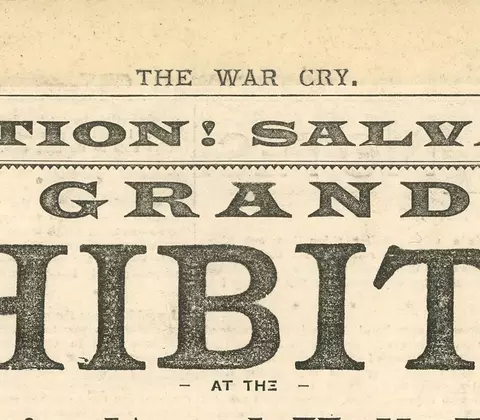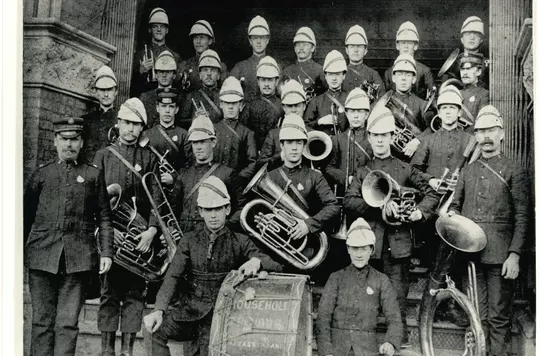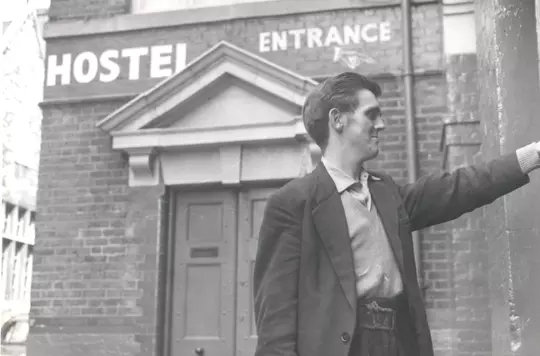
Exhibitions
Our current temporary exhibition was curated by Digital Humanities Project officer, Flore. This exhibition views William Booth’s Darkest England Scheme through the lens of The Darkest England Gazette, the official organ of Salvation Army social work from 1893-1894. You can read digital copies of The Darkest England Gazette in the Resources section of our website.
Establishing The Salvation Army’s Social Work in the Nineteenth Century: The Darkest England Gazette.
From its origins in the 1860s to the present day, The Salvation Army’s social work has gone hand-in-hand with its evangelical mission. The diverse needs of people in poverty have been responded to with both spiritual guidance and material help. In the 1880s these activities led to the establishment of hostels for men and women, soup kitchens, and other support facilities. His book In Darkest England and the Way Out (1890) argued that social problems such as poverty, unemployment, and addiction could be improved by giving people access to food, shelter, and work, converting them to Christianity, and sometimes by helping them to emigrate. His plans became known as the ‘Darkest England Scheme’. This exhibition explores the Darkest England Scheme through the magazine published to promote The Salvation Army’s social work, The Darkest England Gazette. Published weekly from July 1893, it was renamed The Social Gazette in June 1894. The Darkest England Gazette included many, often large illustrations to catch readers’ eye. The images you will see in this exhibition represent some of the many sides of The Salvation Army’s Social Work at the end of the nineteenth century.
Past exhibitions
View digital versions of our previous temporary museum exhibitions.
Work in the First World War
At the outbreak of war in 1914, The Salvation Army began to provide support services to the armed forces and affected civilians. Officers in France, Belgium and Germany immediately redirected their duties into supporting troops and communities behind the front lines. British Salvationists were also sent overseas to assist the British forces and their allies.
As well as supplying motor ambulance units, The Salvation Army’s Naval and Military League set up huts at military camps which offered soldiers rest and refreshment. When the USA entered the conflict in 1917, American huts were famously home to the Salvation Army ‘lassies’ who sustained servicemen with doughnuts when their supplies had dropped to only flour, sugar, lard and canned milk.
A War Department was formed in 1917 and for the remainder of the war it co-ordinated The Salvation Army’s naval and military services, which had become closely associated with their iconic symbol, the red shield. Another aspect of these services involved visiting and sending comfort parcels to prisoners of war and convalescing soldiers. The Salvation Army also cared for refugees from Belgium, Sweden, Finland and Russia.
Post-War Relief
The Post-War Relief Department was established to co-ordinate the Salvation Army's relief work in the closing years of the Second World War, becoming known as the European Relief Department in April 1945.
As part of the Council of British Societies for Relief Abroad (CBSRA), a number of Salvation Army relief teams, or sections, were attached to the British Army of the Rhine (BAOR) in liberated European countries.
The relief teams of the CBSRA worked in Greece, Italy, Austria, Yugoslavia, France, Holland and Germany, in camps and hotels. The teams organised food and clothing distribution, and ran emergency hospitals and travelling clinics.
The images in the video displayed are from the Salvation Army Relief Sections in Germany.
International Congress
2015 saw The Salvation Army host its eighth International Congress.
The first International Congress was held in 1886, just six years after The Salvation Army had expanded overseas. Two thousand officers of sixteen nationalities gathered in London for the event.
The success of the first Congress led to others in 1894, 1904, 1914, 1978, 1990 and 2000. Except for the Atlanta Millennial Congress, all were held in London and featured meetings at well-known venues across the city. For the 1904 and 1914 Congresses grand, temporary venues were also erected in the Strand.
A custom developed during early International Congresses of photographing overseas contingents in ‘traditional’ costume on the steps of The Salvation Army’s Clapton Congress Hall. Some participants expressed displeasure at being asked to ‘return to the vanities put off when salvation was put on’, yet the practice continued as an eye-catching way of emphasising The Army’s diversity.
The images displayed in the video below are from the 1904 Congress.
William Booth College
In 1881 William Booth purchased the London Orphan Asylum in Clapton to use as the principal centre for training Salvation Army officers.
It was decided to move the International Training College to the present site and, in 1928, General Bramwell Booth laid the foundation stone for the new William Booth Memorial Training College. The College was jointly designed by the architects Gordon and Viner, with Sir Giles Gilbert Scott. It was opened in 1929 by Prince George.
The College was designed to accommodate up to 500 unmarried male and female cadets, whose training originally lasted nine months. In 1960 a two year training programme was instituted and, in the mid 1980s, the College was extended to include 16 family apartments.
In 2000 the College was renamed William Booth College and, in September 2011, an extensive refurbishment was completed.
The images in the video below illustrate the history of the College.

Music
Find out about the role that music and song plays within The Salvation Army.

Social work
Discover the origins and history of The Salvation Army’s social work.

War and emergency
Find out about The Salvation Army’s relief work around the world.

A global army
Find out about The Salvation Army’s early growth into a worldwide movement.